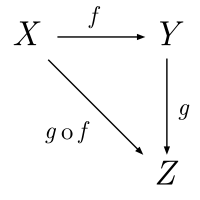Categorification
In mathematics, categorification is the process of replacing set-theoretic theorems by category-theoretic analogues. Categorification, when done successfully, replaces sets by categories, functions with functors, and equations by natural isomorphisms of functors satisfying additional properties. The term was coined by Louis Crane.
The reverse of categorification is the process of decategorification. Decategorification is a systematic process by which isomorphic objects in a category are identified as equal. Whereas decategorification is a straightforward process, categorification is usually much less straightforward, and requires insight into individual situations.
The word (de)categorification doesn't refer to a precise mathematical procedure, but rather to a class of possible analogues. It's used in a similar way to the words like 'generalization', and not like 'sheafification'.[1] Sometimes, the context of an object suggests a natural direction for a categorification of it. For example, in representation theory of Lie algebras mathematicians study modules over some specific algebras. In this case, there are several frameworks for what exactly a categorification of such a module should be, e.g., so called (weak) abelian categorifications, discussed later in the article.[2]
Examples of categorification
One form of categorification takes a structure described in terms of sets, and interprets the sets as isomorphism classes of objects in a category. For example, the set of natural numbers can be seen as the set of cardinalities of finite sets (and any two sets with the same cardinality are isomorphic). In this case, operations on the set of natural numbers, such as addition and multiplication, can be seen as carrying information about products and coproducts of the category of finite sets. Less abstractly, the idea here is that manipulating sets of actual objects, and taking coproducts (combining two sets in a union) or products (building arrays of things to keep track of large numbers of them) came first. Later, the concrete structure of sets was abstracted away – taken "only up to isomorphism", to produce the abstract theory of arithmetic. This is a "decategorification" – categorification reverses this step.
Other examples include homology theories in topology. Emmy Noether gave the modern formulation of homology as the rank of certain free abelian groups by categorifying the notion of a Betti number.[3] See also Khovanov homology as a knot invariant in knot theory.
An example in finite group theory is that the ring of symmetric functions is categorified by the category of representations of the symmetric group. The decategorification map sends the Specht module indexed by partition to the schur function indexed by the same partition:
(essentially following the character map from a favorite basis of the associated Grothendieck group to a representation-theoretic favorite basis of the ring of symmetric functions). This map reflects much of the parallels in structure; for example
have the same decomposition numbers over their respective bases, both given by Littlewood-Richardson coefficients.
Abelian categorifications
For a category , let be the Grothendieck group of .
Let be a ring which is free as an abelian group, and let be a basis of such that the multiplication is positive in , i.e.
with
Let be an -module. Then a (weak) abelian categorification of consists of an abelian category , an isomorphism , and exact endofunctors such that
- the functor lifts the action of on the module , i.e. , and
- there are isomorphisms , i.e. the composition decomposes as the direct sum of functors in the same way that the product decomposes as the linear combination of basis elements .
See also
- Combinatorial proof, the process of replacing number theoretic theorems by set-theoretic analogues.
- Higher category theory
- Higher-dimensional algebra
- Categorical ring
References
- ↑ Alex Hoffnung (2009-11-10). "What precisely Is "Categorification"?".
- ↑ Khovanov, Mikhail; Mazorchuk, Volodymyr; Stroppel, Catharina (2009), "A brief review of abelian categorifications", Theory Appl. Categ., 22 (19): 479–508, arXiv:math.RT/0702746
- ↑ Baez 1998.
- Baez, John; Dolan, James (1998), "Categorification", in Getzler, Ezra; Kapranov, Mikhail, Higher Category Theory, Contemp. Math., 230, Providence, Rhode Island: American Mathematical Society, pp. 1–36, arXiv:math.QA/9802029
- Crane, Louis; Yetter, David N. (1998), "Examples of categorification", Cahiers de Topologie et Géométrie Différentielle Catégoriques, 39 (1): 3–25
- Mazorchuk, Volodymyr, Lectures on Algebraic Categorification, QGM Master Class Series, European Mathematical Society, arXiv:1011.0144, Bibcode:2010arXiv1011.0144M
- Savage, Alistair, Introduction to Categorification, arXiv:1401.6037, Bibcode:2014arXiv1401.6037S
- Khovanov, Mikhail; Mazorchuk, Volodymyr; Stroppel, Catharina (2009), "A brief review of abelian categorifications", Theory Appl. Categ., 22 (19): 479–508, arXiv:math.RT/0702746
Further reading
- A blog post by one of the above authors (Baez): https://golem.ph.utexas.edu/category/2008/10/what_is_categorification.html.
